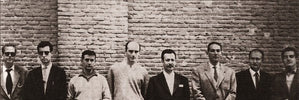
El Paso: From tradition to the avant-garde
, 4 min reading time

, 4 min reading time
Of all the groups of artists who have been formed in Spain in the twentieth century, we can say that El Paso, along with Dau al Set, is undoubtedly the most important in terms of the definition of the Spanish avant-garde.
To understand the origins that led to this formation we must first understand what the situation of Spanish society was in the late 50s. Many years had gone by since the Civil War had ended, and the Franco dictatorship was ruling the country. But until the early 50's Spain was still under an international isolation, as the state was related in its policies to the "axis of evil" during World War II. This led Spain to an autarky that was over thanks to an alliance with the United States against the Soviet Union. Spain had a key geographical location and thus, it was a strategic point during the Cold War.
In the late 50s Spain began to see glimpses of an unremarkable economic recovery for a underclass still too broad.
Within the cultural scene, it was a time of emptiness because many galleries had closed and most of the dealers and collectors seemed to have disappeared. The political and social crisis had left the world of culture standing by and without public activity.
No wonder that some young artists, tired of this situation of cultural poverty, joined to reinvigorate it. These creators, coming from different parts of Spain and each with his particular style, had the same vindictive awareness and need to fight to propel the evolution of Spanish plastic.
And so, in 1957, El Paso; was formed. The artists Antonio Saura, Manuel Rivera, Rafael Canogar, Juana Francés, Manuel Chirino, Luis Feito, Manuel Millares and Pablo Serrano, along with art critics and artists Manuel Conde and José Ayllón signed a manifesto that defined their activity. Shortly thereafter Manuel Rivera joined the collective and the following year, Manuel Viola.
Group members were committed to create an environment that allowed the creative development outside the formalisms established in the fine arts. While most of these artists focused on abstraction, they all rejected the labels imposed and the use of terms such as conceptual, constructivism, expressionism... they believed in free creation and research without borders.
Thus, the Spanish avant-garde art became synonymous of unconformity, break through and rebellion. These concerns were reflected by these artists through their works, whose common nexus between them was the importance of the gesture and the stroke and the voluntary reduction of the usage of colours to a minimum. It is also important to note that for this group the historical value of the country was critic and they all raised a remodelling of the art scene based in tradition. This way, we can see how rough materials such as iron, burlap, chicken wire, sand or paint impasto reflect despair, aggression or loneliness, the heritage of Goya's darkest Spain.
El Paso had only three years of existence, however, it was prolific and international as few Spanish groups have been in history. While its informality was the point of attachment, they never made an explicit critique of the political regime and, since they didn't posed a threat to the government, they became the great ambassadors of the Spanish culture of the moment.
In its first year of existence the artists held many exhibitions in the country, the first one happened to be in the gallery-bookshop Buchholz in Madrid and this summer Millares and Rivera assisted at the Fourth Biennial of Sao Paulo Feito, on behalf of the group. There, Jorge Oteiza obtains the Critics Award for Best sculptor and it is confirmed that the Spanish art is fashionable. So much it is, that the New York MOMA acquires various works of these artists. At the end of 1957 Suárez, Francés, Rivera and Serrano leave the group.
During the next two years until its dissolution numerous exhibitions in museums and galleries, lectures and writings would boost Spanish art, both nationally and internationally. After an intense activity and 15 signed letters, El Paso decided to put an end to its existence in May 1960.
Like many artists of the time, the components of El Paso developed their creativity blindly at a time when the transition to modernity seemed to never come. Like other artists of the informalism, they served as a bridge between tradition and the new trends of the radical avant-garde. But this not only occurred in Spain. The capital of the vanguard was in Paris and American abstract expressionism enjoyed its best. Members of El Paso not only revolutionized the sector and propelled it, but also opened the minds of the Spanish society arousing their interest by international artists such as Mark Rothko, Willem de Kooning, Franz Kline or Robert Motherwell.
Be the first to know about new products and offers!